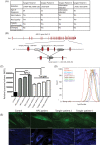Mechanistic convergence and shared therapeutic targets in Niemann-Pick disease
- PMID: 31707734
- PMCID: PMC7317544
- DOI: 10.1002/jimd.12191
Mechanistic convergence and shared therapeutic targets in Niemann-Pick disease
Abstract
Niemann-Pick disease type C (NPC) and Tangier disease are genetically and clinically distinct rare inborn errors of metabolism. NPC is caused by defects in either NPC1 or NPC2; whereas Tangier disease is caused by a defect in ABCA1. Tangier disease is currently without therapy, whereas NPC can be treated with miglustat, a small molecule inhibitor of glycosphingolipid biosynthesis that slows the neurological course of the disease. When a Tangier disease patient was misdiagnosed with NPC and treated with miglustat, her symptoms improved. This prompted us to consider whether there is mechanistic convergence between these two apparently unrelated rare inherited metabolic diseases. In this study, we found that when ABCA1 is defective (Tangier disease) there is secondary inhibition of the NPC disease pathway, linking these two diseases at the level of cellular pathophysiology. In addition, this study further supports the hypothesis that miglustat, as well as other substrate reduction therapies, may be potential therapeutic agents for treating Tangier disease as fibroblasts from multiple Tangier patients were corrected by miglustat treatment.
Keywords: ABCA1; Niemann-Pick disease type C; Tangier disease; lysosome; substrate reduction therapy.
© 2019 The Authors. Journal of Inherited Metabolic Disease published by John Wiley & Sons Ltd on behalf of SSIEM.
Conflict of interest statement
F.M.P. consults for Actelion, F.M.P. and A.G. are co‐founders and consultants to IntraBio. A.C., E.K., E.A., L.D., S.Z., C.Y.T., M.E.F.‐S., P.D., F.D.P. and B.B. declare that they have no conflict of interest.
Figures




References
-
- Lloyd‐Evans E, Morgan AJ, He X, et al. Nieman‐pick disease type C1 is a sphingosine storage disease that causes deregulation of lysosomal calcium. Nat Med. 2008;14(11):1247‐1255. - PubMed
-
- Lloyd‐Evans E, Platt FM. Lipids on trial: the search for the offending metabolite in Niemann‐Pick type C disease. Traffic. 2010;11(4):419‐428. - PubMed
-
- Frederickson D et al. Tangier disease: combined clinical staff conference at the National Institute of health. Ann Intern Med. 1961;55(6):1016‐1031.
-
- Knight B. ATP‐binding cassette transporter A1: regulation of cholesterol efflux. Biochem Soc Trans. 2004;32:124‐127. - PubMed
Publication types
MeSH terms
Substances
Grants and funding
LinkOut - more resources
Full Text Sources
Medical

